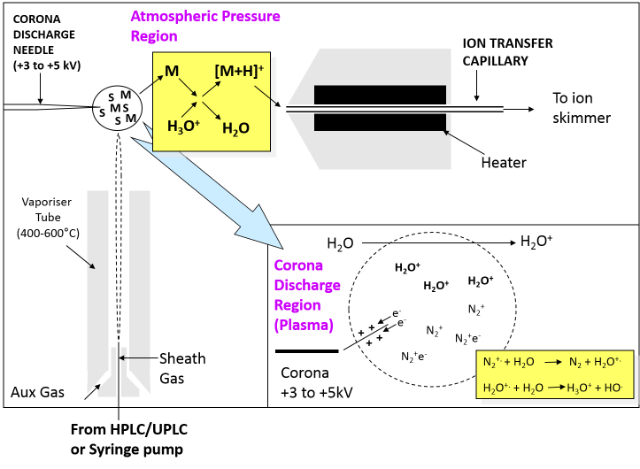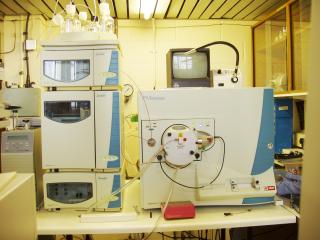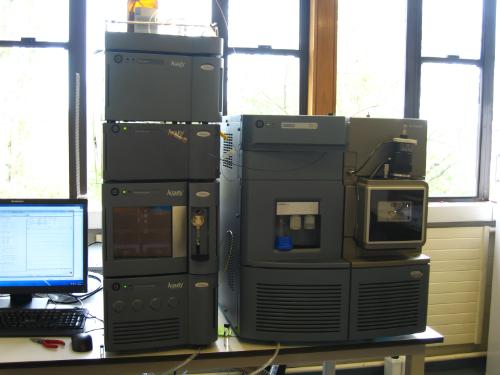Facilities
We have two LCMS instruments; a Thermo LCQ Advantage Ion Trap and a Waters Xevo TQ-S Triple Quad.
For both instruments we use an Atmospheric Pressure Chemical Ionisation (APCI) source for hopanoid analysis. APCI is mainly used for low mass compounds, less than 1500Da, giving mono charged ions. The ions are created directly from solution. Analytes are introduced from the HPLC (or UHPLC) directly into the APCI source. The LC eluent containing the analytes of interest are nebulised into a thin fog using nitrogen gas. These droplets are then desolvated via a heated quartz tube and leave as a mixture of gaseous analyte and hot gas which are then carried along to the corona discharge needle, where nitrogen ions are created. These ions collide with vapourised solvent molecules to form secondary reactant gas ions. These secondary reactant ions can then undergo repeated collisions, charge transfer reactions, with the analyte to form singly charge analyte ions. Ionisation can occur in positive or negative ionisation modes. Positive ionisation generally yields [M+H] +ve ions via proton transfer and negative ionisation yields [M-H] –ve ions via proton loss.

LCQ Advantage Ion Trap
The mass spectrometer on our LCQ is a 3D Ion Trap. Ions are pulled into the ion trap, stabalised, then fragmented. Fragmented ions are scanned out of the trap according to their mass to charge ratio (m/z).
The trap uses an oscillating electric field to store ions. The 3D quadrupole field is created from a circular electrode with two ellipsoid caps on the top and the bottom. Overlapping of a direct potential with an alternative potential gives a 3D quadrupole in which ions of all masses are trapped. The potentials are adjusted so that only ions with selected mass to charge ratio (m/z) will pass through the rods. Ions are expelled according to their mass to charge ratio to obtain the mass spectrum. Since ions in the trap repel each other, their trajectories expand as a function over time. To avoid loss due to this expansion the trajectories are reduced by maintaining the trap under pressure with Helium gas which removes excess energy from the ions via collision.

Xevo TQ-S
The analyser on our Xevo TQ-S system is a Triple Quadrupole. This analyser uses the stability of trajectories in oscillating energy fields to separate ions according to their m/z ratio. A quadrupole is made up four parallel rods; two with positive and two with negative potentials. A positive ion entering the space between the rods will be drawn to the negative rods. The Xevo TQ-S has 3 quardupoles. (Q1, Q2 and Q3) Q1 and Q3 are mass analysers and Q2 is a collision cell made up of a quadrupole using RF only.

A collision gas, Argon, is introduced to the central quadrupole at pressure so that an ion entering undergoes one or several collisions.
There are four main modes that can be used
1) Daughter scan/ product ion scan
Q1 is used to select an ion with a chosen m/z, the ion collides in the central quadrupole(Q2) and reacts or fragments. All of the products are analysed by second mass analyser Q3.
2) Parent Scan
The second mass analyser (Q3) is focused on a selected ion while the first mass analyser (Q1) is used for precursor scan. All of the ions that produce the selected mass through reaction or fragmentation are detected.
3) Neutral Loss scan
Both mass analysers (Q1 and Q3) are scanned together, but with a constant mass offset. Ions are detected, that by fragmentation in Q2, lead to the loss of a specified neutral fragment, such as water.
4) Selected Reaction Monitoring (SRM)/ Multiple Reaction Monitoring (MRM)
Q1 and Q3 are set to a specific m/z allowing only a fragment ion from a specific precursor ion to be detected. If Q1 and/or Q3 are set to more than one specific mass then this technique is known as MRM.
